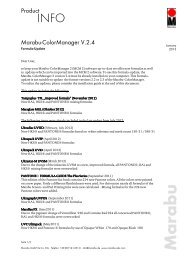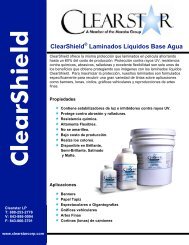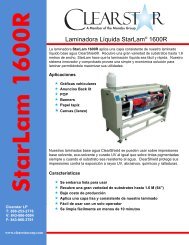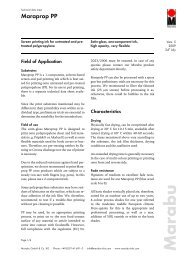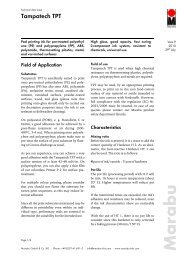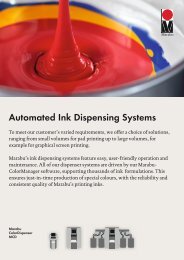Ultraglass UVGO - Marabu Printing Inks
Ultraglass UVGO - Marabu Printing Inks
Ultraglass UVGO - Marabu Printing Inks
Create successful ePaper yourself
Turn your PDF publications into a flip-book with our unique Google optimized e-Paper software.
Technical Data Sheet<br />
<strong>Ultraglass</strong> <strong>UVGO</strong><br />
UV screen printing ink for packaging and<br />
restaurant glass, as well as float glass<br />
suited for indoor use, ceramics, metals,<br />
anodized aluminium, and varnished<br />
surfaces<br />
High gloss, fast curing, excellent dish<br />
washer resistance, very good alkaline<br />
and chemical resistance<br />
Vers.10<br />
2013<br />
21. Feb<br />
Field of Application<br />
Substrates and field of use<br />
<strong>Ultraglass</strong> <strong>UVGO</strong> is a UV curable screen printing<br />
ink especially suited for<br />
• Pre-treated, cold end coated packaging<br />
glass, e.g. drinking bottles<br />
• Pre-treated and non pre-treated cosmetic<br />
bottles<br />
• Pre-treated restaurant glass, e.g. drinking<br />
glasses, ashtrays, vases<br />
• Pre-treated and non pre-treated float glass<br />
for indoor use, e.g. gambling machines,<br />
glass for furniture, dividers, and many<br />
more<br />
• Ceramics<br />
• Metals<br />
• Anodized aluminium<br />
• Varnished surfaces<br />
Since all the print substrates mentioned may be<br />
different in printability even within an individual<br />
type, preliminary trials are essential to determine<br />
suitability for the intended use.<br />
Characteristics<br />
Ink characteristics<br />
<strong>UVGO</strong> is a 2-component ink system. Prior to<br />
printing, it is to add Adhesion Modifier UV-<br />
HV 8 in the correct quantity and to stir homogeneously.<br />
This mixture has a pot life of min.<br />
8 hours referred to a room temperature of 18°<br />
to 25° C.<br />
All <strong>UVGO</strong> shades are high-glossy and brilliant.<br />
They can also be metal-coated if required.<br />
<strong>UVGO</strong> is a fast curing ink and therefore also<br />
suited for high printing speeds at white glass<br />
production of up to 80 passes/min.<br />
For a good adhesion, a uniform surface tension<br />
of > 44 mN/m is generally important.<br />
Furthermore, the glass surface must absolutely<br />
be free from graphite, silicone, dust or residues<br />
like grease or similar (e.g. fingerprints).<br />
A pre-treatment of the glass by flaming immediately<br />
before printing will generally enhance<br />
the adhesion of the ink to the substrate. When<br />
using cold end coated glass, the flaming is necessarily<br />
to be carried out. Best possible adhesion<br />
is achieved by Uvitro ® or Pyrosil ® pretreatment.<br />
Page 1/5<br />
Adjustment of the ink<br />
Before printing, it is to adjust <strong>Ultraglass</strong> <strong>UVGO</strong><br />
with Adhesion Modifier UV-HV 8 as follows<br />
(pot life approx. 8 h):<br />
2% of UV-HV 8: colour shades, black, 4-colour<br />
process shades and varnish<br />
4% of UV-HV 8: white, opaque white, highopaque<br />
colours and colour<br />
matches with a percentage of<br />
white > 50%, bronzes and<br />
etch imitation effects<br />
For vertical screen printing, as well as automatic<br />
ink feeding, the viscosity can further be reduced<br />
by adding 1-10% of thinner UVV 6 to<br />
the ink. During the curing process, the thinner<br />
will be chemically crosslinked and must therefore<br />
not be overdosed.<br />
<strong>Marabu</strong> GmbH & Co. KG ⋅ Phone: +49 7141 691 0 ⋅ info@marabu-inks.com ⋅ www.marabu-inks.com<br />
<strong>Marabu</strong>
Technical Data Sheet<br />
<strong>Ultraglass</strong> <strong>UVGO</strong><br />
Curing<br />
<strong>Ultraglass</strong> <strong>UVGO</strong> is a fast curing UV-ink. A<br />
UV-curing unit with one medium pressure<br />
Mercury Vapour Lamp (180- 200 W/cm) will<br />
cure <strong>UVGO</strong> at a belt speed of 4800 passes/h.<br />
<strong>UVGO</strong> 170 Opaque White, all high opaque<br />
shades and bronzes cures more slowly due to<br />
their high amount of pigments (approx. 3300<br />
passes/h).<br />
The curing speed of the ink is generally dependant<br />
upon the kind of UV-curing unit<br />
(reflector), number, age and power of the UVlamps,<br />
the printed ink film thickness, the selfcolour<br />
of the glass, as well as the number of<br />
passes of the UV-curing unit.<br />
Oven drying<br />
After UV-curing, the following oven drying<br />
forced by heat is necessary:<br />
160° C for 20 min. or 140° C for 30 min.<br />
By doing this, the best possible adhesion to the<br />
glass as well as high resistance is achieved.<br />
In the case of lower requirements to the final<br />
product, IR drying can be used or also<br />
completely done without IR or oven drying.<br />
The ink will post-cure within the first 24 hours<br />
and resistances can be tested only after that<br />
time. Preliminary tests, however, are always<br />
necessary.<br />
• domestic dish washer minimum 300<br />
cycles (65°C for 130 min with customary<br />
cleaner Type B/low alkaline detergent)<br />
• Winterhalter glass dish washer (85° C for<br />
3 min), minimum 3000 cycles<br />
• alkaline resistance: 2.3% of NaOH (80° C<br />
for 30 min)<br />
• 500 double rub strokes (350 g): ethanol<br />
and glass cleansing agent were found to be<br />
o.k.<br />
• 100 double rub strokes (350 g): acetone<br />
was found to be in order<br />
• resistance to perfume: after 24 h long term<br />
test o.k.<br />
• ink adhesion after frost test at -18° C was<br />
o.k.<br />
Bright colour shades, e.g. white, may darken if<br />
the print is constantly exposed to temperatures<br />
>40° C.<br />
Range<br />
Basic Shades - System Ultracolor<br />
922 Light Yellow 952 Ultramarin Blue<br />
924 Med. Yellow 956 Brilliant Blue<br />
926 Orange 960 Blue Green<br />
932 Scarlet Red 962 Grass Green<br />
934 Carmine Red 970 White<br />
936 Magenta 980 Black<br />
950 Violet<br />
High-opaque shades<br />
Fade resistance<br />
Pigments of medium to high fade resistance are<br />
used in the <strong>Ultraglass</strong> <strong>UVGO</strong> ink type. Owing<br />
to the binding agent used, however, all <strong>UVGO</strong><br />
shades are suited to a limited outdoor use of up<br />
to 3 months.<br />
Stress resistance<br />
The following resistances are referred to ovendried<br />
prints:<br />
Page 2/5<br />
122 Light Yellow<br />
132 Scarlet Red<br />
152 Ultramarine Blue<br />
162 Grass Green<br />
170 Opaque White<br />
180 Opaque Black<br />
Etch imitations<br />
913 Milky matt<br />
914 Satin Gloss Transparent<br />
916 Structured<br />
<strong>Marabu</strong> GmbH & Co. KG ⋅ Phone: +49 7141 691 0 ⋅ info@marabu-inks.com ⋅ www.marabu-inks.com<br />
<strong>Marabu</strong>
Technical Data Sheet<br />
<strong>Ultraglass</strong> <strong>UVGO</strong><br />
Shades for 4-colour process printing<br />
If 4-colour process shades are required, please<br />
refer to the ink line UVGL. Thanks to similar<br />
product properties, the UVGL 4-colour process<br />
shades are fully compatible with <strong>UVGO</strong>.<br />
All shades are intermixable. Mixing with other<br />
ink types should be avoided in order to maintain<br />
the special characteristics of this outstanding<br />
ink range.<br />
The basic shades according to System Ultracolor<br />
are included in our <strong>Marabu</strong>-ColorForulator<br />
(MCF). They build the basis for the calculation<br />
of individual colour matching formulas,<br />
as well as for shades of the common colour<br />
reference systems Pantone®, HKS®, and<br />
RAL®. All formulas are stored in the <strong>Marabu</strong>-<br />
ColorManager software.<br />
All shades are based on organic pigments, therefore,<br />
the heavy metal content complies with<br />
the EEC regulations EN 71, part 3, "Safety of<br />
toys" - migration of specific elements.<br />
Varnish <strong>UVGO</strong> 65495910ZS#<br />
Silicone<br />
cone-free<br />
printing varnish, featuring even<br />
higher transparency. Suitable as a primer for<br />
hot stamping foils, as overprint varnish or<br />
extender, as bronze binder for high-gloss<br />
bronzes, and for window decorations on acidfrosted<br />
glass substrates.<br />
Bronzes<br />
Various bronze pastes are available which can<br />
be mixed with <strong>UVGO</strong> 910. They can be chosen<br />
according to the required opacity, cost limit,<br />
visual impression, and curing characteristics.<br />
Low-priced, slightly structured Bronze<br />
Pastes<br />
fair opacity<br />
S-UV 191 Silver 4:1- 7:1<br />
S-UV 192 Rich Pale Gold 4:1- 7:1<br />
S-UV 193 Rich Gold 4:1- 7:1<br />
Shelf life varnish + bronze: 6 months<br />
Shelf life varnish + bronze + HV 8: 8 hours<br />
Please note that there is no FDA approval for<br />
<strong>UVGO</strong> as we did not use explicitly FDA-approved<br />
materials for the formulation of the ink.<br />
Additives<br />
Special Binder <strong>UVGO</strong> 904<br />
Addition:<br />
1 - 25% parts by weight<br />
An addition of Special Binder <strong>UVGO</strong> 904<br />
will accelerate the curing speed reducing,<br />
however, the opacity. It is not highly<br />
transparent.<br />
Overprint Varnish <strong>UVGO</strong> 910<br />
Highly transparent overprint varnish for overvarnishing<br />
or an individual addition of varnish,<br />
also suited as a bronze binder for high-gloss<br />
bronzes as well as for window decorations on<br />
obscured glass surfaces.<br />
Page 3/5<br />
High-gloss fine bronzes<br />
excellent opacity<br />
S-UV 296 High-gloss Silver 6:1 — 9:1<br />
S-UV 297 High-gloss Rich Pale Gold 6:1 — 9:1<br />
S-UV 298 High-gloss Pale Gold 6:1 — 9:1<br />
Shelf life varnish + bronze: 24 hours<br />
Shelf life varnish + bronze + HV 8: 8 hours<br />
Due to the reduced rub resistance, an overprint<br />
with <strong>UVGO</strong> 910 is recommended.<br />
High-opaque metallic bronzes<br />
Slightly structured, excellent rub resistance<br />
S-UV 291 High-gloss Silver 4:1 — 10:1<br />
S-UV 293 High-gloss Rich Gold 4:1 — 10:1<br />
Shelf life varnish + bronze: 12 hours<br />
Shelf life varnish + bronze + HV 8: 8 hours<br />
All figures in brackets are guidelines which can<br />
be varied according to opacity and curing<br />
speed. The ratio figures in brackets refer to the<br />
<strong>Marabu</strong> GmbH & Co. KG ⋅ Phone: +49 7141 691 0 ⋅ info@marabu-inks.com ⋅ www.marabu-inks.com<br />
<strong>Marabu</strong>
Technical Data Sheet<br />
<strong>Ultraglass</strong> <strong>UVGO</strong><br />
mixture Bronze Binder <strong>UVGO</strong> 910 to bronze<br />
powder whereas the first figure is standing for<br />
the parts by weight of <strong>UVGO</strong> 910.<br />
Prior to printing, it is to add 4% Adhesion<br />
Modifier UV-HV 8 to the mixture <strong>UVGO</strong> 910<br />
plus high-gloss bronze/paste and to stir<br />
homogeneously. The processing time (pot life)<br />
is min. 8 h referred to a room temperature of<br />
max. 25° C.<br />
Auxiliaries<br />
Adhesion Modifier UV-HV 8<br />
Prior to printing, it is to add Adhesion Modifier<br />
UV-HV 8 to the ink (pot life approx. 8 h). More<br />
details see the chapter “Adjustment of the ink”<br />
on page 1.<br />
recommend a fabric between 150-27 and 180-<br />
27 (1:1 plain weave) instead.<br />
A high and uniform screen tension (>16 N) is<br />
further important to guarantee a defined ink<br />
deposit.<br />
<strong>UVGO</strong> can be processed with all solvent-resistant<br />
stencil technics such as capillary films<br />
(15-20µ), photo emulsions or combination<br />
stencils.<br />
Mileage<br />
Mileage is about 50-70 m 2 /kg of printed<br />
surface according to mesh and substrate<br />
chosen.<br />
Shelf life<br />
Thinner UVV 6<br />
Addition:<br />
Page 4/5<br />
1 - 10 % parts by weight<br />
Thinner for reducing the printing viscosity at<br />
vertical screen printing or automatic ink feeding<br />
by pump operation.<br />
Cleaning<br />
For manual cleaning of screen printing stencils<br />
and tools our cleaner UR 3 (flash point 42° C)<br />
or UR 4 (flash point 52°C) can be used.<br />
Ink residues mixed with adhesion modifier<br />
must be removed from the screen immediately<br />
after printing.<br />
Fabrics, stencils<br />
The fabric selection depends on the desired<br />
curing speed and productivity, as well as the<br />
requested opacity. Generally, all fabrics from<br />
120-34 to 165-27 (1:1 plain weave) can be used<br />
but we especially recommend a 140-31 mesh.<br />
For the printing of 4-colour process shades, we<br />
Shelf life depends very much on the formula/<br />
reactivity of the ink system as well as the storage<br />
temperature. It is 2 years for an unopened<br />
ink if stored in a dark room at a temperature of<br />
15°C to 25°C. Under different conditions,<br />
particularly higher storage temperatures, the<br />
shelf life is reduced. In such cases, <strong>Marabu</strong>’s<br />
warranty expires.<br />
Labelling<br />
For our ink type <strong>Ultraglass</strong><strong>UVGO</strong> and its additives<br />
and auxiliaries there are current Material<br />
Safety Data Sheets available according to ECregulation<br />
1907/2006, covering in detail all<br />
relevant safety data including the labelling<br />
according to the present EC regulations as to<br />
health and safety labelling requirements. Such<br />
health and safety data may also be obtained<br />
from the respective label.<br />
<strong>Marabu</strong> GmbH & Co. KG ⋅ Phone: +49 7141 691 0 ⋅ info@marabu-inks.com ⋅ www.marabu-inks.com<br />
<strong>Marabu</strong>
Technical Data Sheet<br />
<strong>Ultraglass</strong> <strong>UVGO</strong><br />
Safety Regulations for UV<br />
Screen <strong>Printing</strong> <strong>Inks</strong><br />
UV inks contain skin irritating material. Therefore,<br />
we recommend that all UV-curing screen<br />
printing inks and auxiliaries should be handled<br />
with particular care. Skin polluted with ink<br />
must be cleaned immediately with water and<br />
soap. Please pay also attention to the notes on<br />
labels and safety data sheets.<br />
Note<br />
Our technical advice whether spoken, written,<br />
or through test trials corresponds to our current<br />
knowledge to inform about our products<br />
and their use. This is not meant as an assurance<br />
for certain properties of the products nor their<br />
suitability for each application.<br />
You are, therefore, obliged to conduct your<br />
own tests with our supplied products to confirm<br />
their suitability for the desired process or<br />
purpose. The selection and testing of the ink<br />
for specific application is exclusively your responsibility.<br />
Should, however, any liability claims arise,<br />
such claims shall be limited to the value of the<br />
goods delivered by us and utilised by you with<br />
respect to any and all damages not caused intentionally<br />
or by gross negligence.<br />
Page 5/5<br />
<strong>Marabu</strong> GmbH & Co. KG ⋅ Phone: +49 7141 691 0 ⋅ info@marabu-inks.com ⋅ www.marabu-inks.com<br />
<strong>Marabu</strong>




